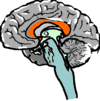 |
The Corpus Callosum |
The corpus callosum (CC) is a large bundle of axons that interconnect neurons in the two
cerebral hemispheres. Several years ago we rediscovered something originally noted by
Richard Wimer in the mouse strains BALB/c and 129: often there is no corpus callosum. This
neurological defect is especially interesting because BALB/c mice are highly inbred and
therefore genetically homogeneous. Nonetheless, the outcome of development is highly
variable; littermate embryos adjacent to each other in the uterus often have radically different
brains, one being quite normal and the other having no CC. This variation arises from a third
source of individual differences generated inside the embryo and is neither hereditary nor
environmental. We have utilized this within-strain variation to study the causes of abnormal
axon rerouting and the behavioural consequences of having no CC. Genetic experiments
revealed that the difference between the BALB/c and 129 strains pertinent to CC development
most likely entails only two major loci. We are now working on a genetic linkage study to
localize these genes to chromosomal regions.
Three inbred mouse strains are currently maintained in the laboratory because of their special relevance to the problem of absent CC. Limited numbers of animals are available to qualified investigators for collaborative research and to establish separate breeding colonies.
BALB/cWah1 was originally derived from BALB/cJ via Carworth Farms and has been inbred in my lab since 1976. About 20% of mice have no CC and another 20 to 30% have an unusually small CC. The hippocampal commissure (HC) is almost always normal.
9XC-1/Wah is a recombinant inbred strain originating from the hybrid cross of a 129/ReJ female and a BALB/cWah1 male. The strain shows 100% total absence of the CC and also suffers a greatly reduced HC. These mice breed surprisingly well.
9XC-2/Wah originated from the same cross as 9XC-1/Wah, but most mice have a
normal CC and the HC is virtually always normal.
Ozaki, H.S., and Wahlsten, D. Timing and origin of the first cortical axons to project through
the corpus callosum and the subsequent emergence of callosal projection cells in the mouse.
Journal of Comparative Neurology, 1998, 400, 197-206.
Bishop, K., and Wahlsten, D. Sex differences in the human corpus callosum: Myth or reality?
Neuroscience and Biobehavioral Reviews, 1997, 21, 581-601.
Livy, D. J., and Wahlsten, D. Formation of the hippocampal commissure in normal and
acallosal mouse embryos. Hippocampus, 1997, 7, 2-14.
Livy, D.J., Schalomon, P.M., Roy, M., Zacharias, M.C., Pimenta, J., Lent, R., and
Wahlsten, D. Increased axon number in the anterior commissure of mice lacking a corpus
callosum. Experimental Neurology, 1997, 146, 491-501.
Bishop, K., Kruyer, A., and Wahlsten, D. Agenesis of the corpus callosum and voluntary
wheel running in mice. Psychobiology, 1996, 24, 187-194.
Schalomon, P. M, and Wahlsten, D. A precision surgical approach for complete or partial
callostomy in the mouse. Physiology and Behavior, 1995, 57, 1199-1203.
Wahlsten, D., and Ozaki, H.S. Defects of the fetal forebrain in acallosal mice. In:
M. Lassonde & M. Jeeves (Eds.), Callosal Agenesis, New York: Plenum Press, 1994. pp.
125-133.
Wahlsten, D., and Bulman-Fleming, B. Retarded growth of the medial septum: A major
gene effect in acallosal mice. Developmental Brain Research, 1994, 77, 203-214.
Ozaki, H.S., and Wahlsten, D. Cortical axon trajectories and growth cone morphologies in
fetuses of acallosal mouse strains. Journal of Comparative Neurology, 1993, 336, 595-604.
Ozaki, H.S., and Wahlsten, D. Prenatal formation of the normal mouse corpus callosum: A
quantitative study with carbocyanine dyes. Journal of Comparative Neurology, 1992, 323; 81-90.
Livy, D.J., and Wahlsten, D. Tests of genetic allelism between four inbred mouse strains
with absent corpus callosum. Journal of Heredity, 1991, 82, 459-464.
Bulman-Fleming, B., and Wahlsten, D. The effects of intrauterine position on the degree of
corpus callosum deficiency in two substrains of BALB/c mice. Developmental Psychobiology,
1991, 24, 395-412.
Wahlsten, D. Deficiency of the corpus callosum: Incomplete penetrance and substrain
differentiation in BALB/c mice. Journal of Neurogenetics, 1989, 5, 61-76.
Wahlsten, D. Genetic and developmental defects of the mouse corpus callosum. Experientia,
1989, 45, 828-838.